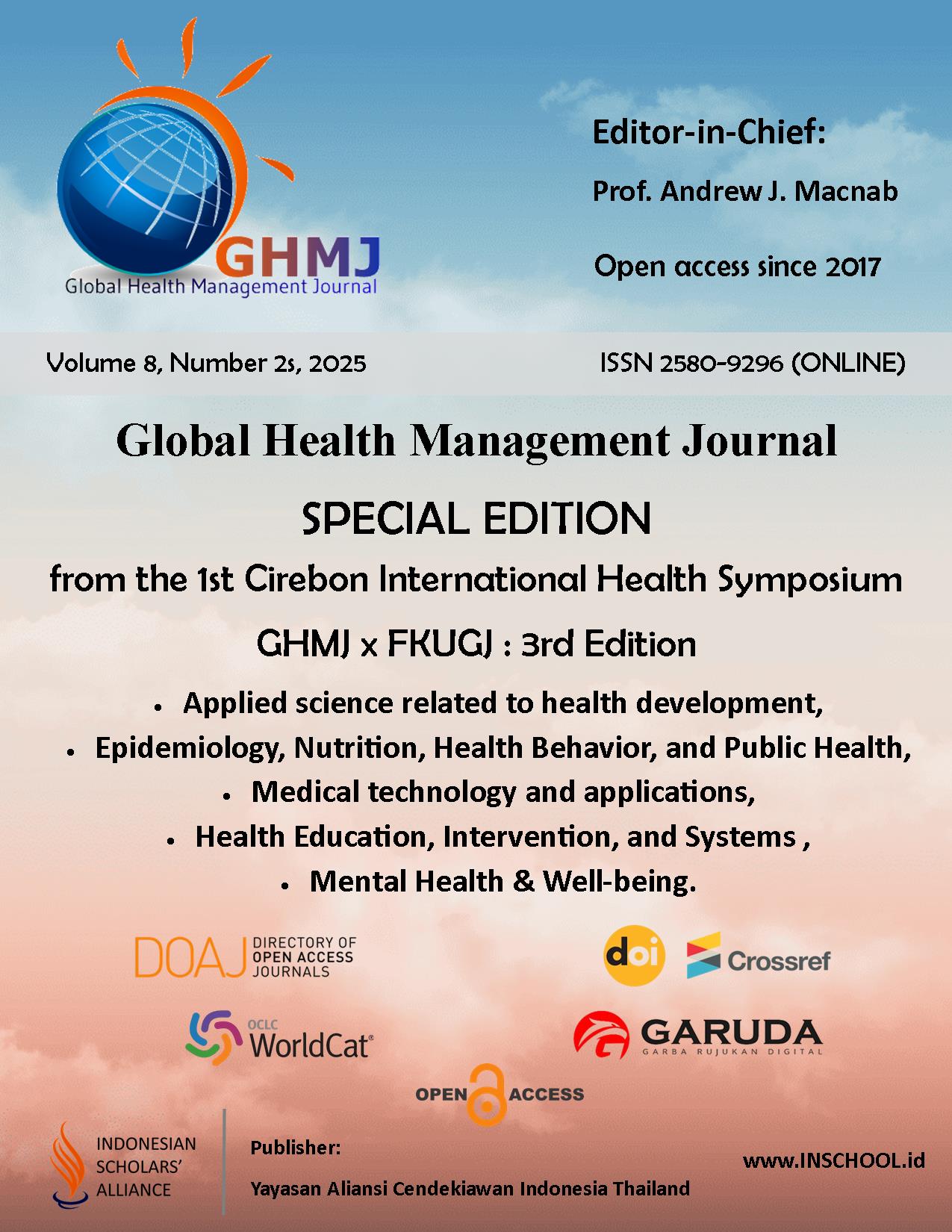Examination of Coliform and Escherichia coli Contamination in Refilled Drinking Water in Cirebon Regency, Indonesia
DOI:
https://doi.org/10.35898/ghmj-82s1224Keywords:
Coliform, Escherichia coli, Refillable drinking waterAbstract
Background: Refillable drinking water is a commonly used source of water for the public. Contamination of this water can lead to various diseases, including waterborne diarrhea. Coliform bacteria and Escherichia coli are indicators of faecal contamination and can cause waterborne diseases. This study aims to determine whether Coliform and Escherichia coli are present in refillable drinking water in Cirebon Regency.
Aims: To identify the presence of Coliform and Escherichia coli bacteria in refillable drinking water in Cirebon Regency.
Methods: This descriptive study employed purposive sampling to collect six samples of refillable drinking water from six different depots located in Cirebon Regency. Each sample was tested four times using various laboratory tests, including Nutrient Agar, Mac Conkey Agar, Gram Staining, IMVIC, and TSIA.
Results: All samples showed the presence of Coliform (100%), as shown by the Mac Conkey Agar test indicating lactose fermentation and Gramme Staining revealing rod-shaped bacteria. However, Escherichia coli was not found (0%) in any of the samples. The results of the Mac Conkey Agar test as a lactose fermenter, Gram Staining showing rod-shaped bacteria, and IMVIC tests showed the following profile: Indole +, MR +, VP -, Citrate -, and TSIA: A/A, H₂S -, Gas +. While Escherichia coli was absent, the detection of other Coliforms suggests persistent hygiene issues; Citrobacter freundii and Klebsiella were found to be Coliform bacteria.
Conclusion: No Escherichia coli were detected in any of the samples, but Coliform bacteria were found in 6 out of 6 samples (100%). The maintenance of refillable drinking water depots is crucial for public health. Owners must frequently clean and disinfect the reservoirs to prevent contamination. Additionally, authorities are responsible for regularly monitoring the hygiene and sanitation of these depots.
Downloads
References
Amin SS., Ghozali TZ., Efendi MRS. (2023). Identifikasi Bakteri dari Telapak Tangan dengan Pewarnaan Gram. Jurnal Kimia dan Ilmu Lingkungan. (1), 30-35. https://ojs.ejournalunigoro.com/index.php/CHEMVIRO/article/view/563/409
Apriani DGY, Putri DMSF, Widiasari NS. (2022). Gambaran Umum Tingkat Pengetahuan Ibu Tentang Diare pada Balita di Desa Baler Bale Agung, Kabupaten Jembrana Tahun 2021. J Heal Med Sci. 1(3):15-26. https://pusdikra-publishing.com/index.php/jkes/article/view/714
Apriani, Bintari NWD, Ilsan NA, Istyanto F, Suhartati R, Dewi RK, Zuraida, Herlina, Inggraini M, Djasfar SP, Nur J, Setiawan D, Wijayanti DR, Safari WF. (2014). Bakteriologi untuk Mahasiswa Kesehatan. Masagena Mandiri Medica. Makassar; (20).
Apriyanthi DPRV., Laksmita AS., Widayanti NP. (2022). Identifikasi Bakteri Kontaminan pada Gelang Tri Datu. Jurnal Biologi Makassar, 7(2). https://journal.unhas.ac.id/index.php/bioma/article/view/21214
Arumsari, F., Joko, T., & Darundiati, Y. H. (2021). Hubungan Higiene Sanitasi Depot Air Minum dengan Keberadaan Bakteri Escherichia coli pada Air Minum Isi Ulang di Kecamatan Mondokan Kabupaten Sragen. MEDIA KESEHATAN MASYARAKAT INDONESIA, 20(2), 75–82. https://doi.org/10.14710/mkmi.20.2.75-82
Azizah, A., & Soesetyaningsih, E. (2020). Akurasi Perhitungan Bakteri pada Daging Sapi Menggunakan Metode Hitung Cawan. BERKALA SAINSTEK, 8(3), 75. https://doi.org/10.19184/bst.v8i3.16828
Hijriani, H., Agustini, N. A., & Karnila, N. A. (2020). Pengetahuan Perilaku Hidup Bersih Sehat (Phbs) Pada Anak Dengan Diare Di Rumah Sakit Umum Kelas B Kabupaten Subang. Jurnal Health Sains, 1(5), 288–293. https://doi.org/10.46799/jhs.v1i5.51
Jung B, Hoilat GJ. Mac Conkey Medium. [Updated 2024 Sep 10]. In: StatPearls [Internet]. Treasure Island (FL): StatPearls Publishing; 2025 Jan-. Available from: https://www.ncbi.nlm.nih.gov/books/NBK557394
Kementerian Kesehatan. (2010). Peraturan Menteri Kesehatan Republik Indonesia Nomor 492/MENKES/PER/IV/2010 Tentang Persyaratan Kualitas Air Minum.
Khairunnida, G. R., Rusmini, H., Maharyuni, E., & Warganegara, E. (2020). Identifikasi Escherichia coli Penyebab Waterborne Disease pada Air Mimun Kemasan dan Air Mimunm Isi Ulang. JURNAL ILMIAH KESEHATAN SANDI HUSADA, 12(2), 634–639. https://doi.org/10.35816/jiskh.v12i2.370
Masruroh, M., Sudaryo, M. K., & Nurlina, A. (2022). Situasi Masalah Kesehatan Penyakit Menular di Kabupaten Cirebon. HIGEIA (Journal of Public Health Research and Development), 6(4), 237–249. https://doi.org/10.15294/higeia.v6i4.58645
Mueller M, Tainter CR. Infeksi Escherichia coli. [Diperbarui 13 Juli 2023]. Dalam: StatPearls [Internet]. Treasure Island (FL): StatPearls Publishing; 2024 Jan-. https://www.ncbi.nlm.nih.gov/books/NBK564298/
Muhammad N. Persentase Rumah Tangga Indonesia Berdasarkan Sumber Air Minum Utama. Katadata Media Network. 2023:1-8.
Nariswari I, Musdalifah E. (2023). Diare Akut Berair dengan Dehidrasi Ringan hingga Sedang. Pendidikan Kedokteran Berkelanjutan, Fakultas Kedokteran, Universitas Muhammadiyah Surakarta. https://proceedings.ums.ac.id/kedokteran/article/view/2806
Putri SG, Yanti, Erfina, Khafifa N. (2023). Analisis Kuantitatif Bakteri Coliform pada Air Minum di Depot Air Minum Isi Ulang di Desa Tahoa, Kabupaten Kolaka. Jurnal Biopedagogia. 5(1). http://jurnal.borneo.ac.id/index.php/biopedagogia/article/view/3569
Rezkina, N. K., & Roslina, N. A. (2024). Perbandingan Pertumbuhan Escherichia coli Dan Salmonella Sp Pada Hari Pertama Dan Hari Kedua Di Depot Air Minum Isi Ulang. Jurnal Kedokteran Dan Kesehatan Publikasi Ilmiah Fakultas Kedokteran Universitas Sriwijaya, 11(1), 22–31. https://doi.org/10.32539/jkk.v11i1.225
Rophi, A. H. (2022). Analisis Mutu Air Secara Mikrobiologi Pada Perlindungan Mata Air Di Kelurahan Sentani Kota Distrik Sentani Kota Kabupaten Jayapura. Bio-Lectura Jurnal Pendidikan Biologi, 9(1), 42–54. https://doi.org/10.31849/bl.v9i1.9257
Saputri, E. T., & Efendy, M. (2020). Kepadatan Bakteri Coliform Sebagai Indikator Pencemaran Biologis Di Perairan Pesisir Sepuluh Kabupaten Bangkalan. Juvenil Jurnal Ilmiah Kelautan Dan Perikanan, 1(2), 243–249. https://doi.org/10.21107/juvenil.v1i2.7579
Umarudin, Adniyana GA, Rohayanti, Slamet NS, Sembiring F, Rakanita Y, Sari NKY, Sumariangen AB, Kurniati I, Yuliawati, Permatasari AAAP, Merdekawarti F, Dermawan A. (2020) BAKTERIOLOGI 2. Medika Sains Indonesia.
Yuliandi, N. N. E., Apriani, N., & Marantika, N. a. V. (2022). Identifikasi Cemaran Bakteri Escherichia coli Pada Ayam Broiler di Pasar Pos Duri Jakarta Barat. Jurnal Ilmu Kedokteran Dan Kesehatan Indonesia, 2(2), 25–29. https://doi.org/10.55606/jikki.v2i2.362
Downloads
Published
Issue
Section
Categories
License
Copyright (c) 2025 Ana Naela Shonia, S.Ked, Hikmah Fitriani, S.Si., M.Si.Med, dr. Mohammad Erwin Indrakusuma, Sp.MK

This work is licensed under a Creative Commons Attribution-NonCommercial-ShareAlike 4.0 International License.
GHMJ (Global Health Management Journal) conforms fully to The Budapest Open Access Initiative (BOAI) and DOAJ Open Access Definition. Authors, readers, and reviewers are free to Share ” copy and redistribute the material in any medium or format, and Adapt ” remix, transform, and build upon the material. Author(s) retain unrestricted copyrights and publishing rights of their work. The licensor cannot revoke these freedoms as long as you follow the license terms. Learn the details at the License policy.





















